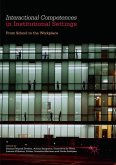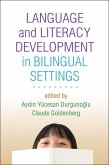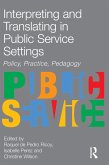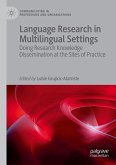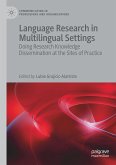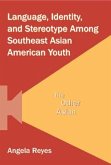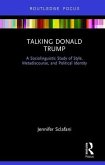Luca Iezzi
Multilingualism in Italian Migrant Settings
Luca Iezzi
Multilingualism in Italian Migrant Settings
- Gebundenes Buch
- Merkliste
- Auf die Merkliste
- Bewerten Bewerten
- Teilen
- Produkt teilen
- Produkterinnerung
- Produkterinnerung
Multilingualism in Italian Migrant Settings investigates the plural linguistic practices of the migrants in a particular refugee centre in Italy, the CAS ('extraordinary refugee centre').
Andere Kunden interessierten sich auch für
![Interactional Competences in Institutional Settings Interactional Competences in Institutional Settings]() Interactional Competences in Institutional Settings59,99 €
Interactional Competences in Institutional Settings59,99 €![Language and Literacy Development in Bilingual Settings Language and Literacy Development in Bilingual Settings]() Language and Literacy Development in Bilingual Settings82,99 €
Language and Literacy Development in Bilingual Settings82,99 €![Interpreting and Translating in Public Service Settings Interpreting and Translating in Public Service Settings]() Interpreting and Translating in Public Service Settings202,99 €
Interpreting and Translating in Public Service Settings202,99 €![Language Research in Multilingual Settings Language Research in Multilingual Settings]() Language Research in Multilingual Settings160,49 €
Language Research in Multilingual Settings160,49 €![Language Research in Multilingual Settings Language Research in Multilingual Settings]() Language Research in Multilingual Settings110,99 €
Language Research in Multilingual Settings110,99 €![Language, Identity, and Stereotype Among Southeast Asian American Youth Language, Identity, and Stereotype Among Southeast Asian American Youth]() Angela ReyesLanguage, Identity, and Stereotype Among Southeast Asian American Youth160,99 €
Angela ReyesLanguage, Identity, and Stereotype Among Southeast Asian American Youth160,99 €![Talking Donald Trump Talking Donald Trump]() Jennifer SclafaniTalking Donald Trump87,99 €
Jennifer SclafaniTalking Donald Trump87,99 €-
-
-
Multilingualism in Italian Migrant Settings investigates the plural linguistic practices of the migrants in a particular refugee centre in Italy, the CAS ('extraordinary refugee centre').
Hinweis: Dieser Artikel kann nur an eine deutsche Lieferadresse ausgeliefert werden.
Hinweis: Dieser Artikel kann nur an eine deutsche Lieferadresse ausgeliefert werden.
Produktdetails
- Produktdetails
- Verlag: Taylor & Francis Ltd (Sales)
- Seitenzahl: 146
- Erscheinungstermin: 26. September 2024
- Englisch
- Abmessung: 234mm x 156mm x 11mm
- Gewicht: 404g
- ISBN-13: 9781032684642
- ISBN-10: 103268464X
- Artikelnr.: 70203398
- Herstellerkennzeichnung
- Libri GmbH
- Europaallee 1
- 36244 Bad Hersfeld
- 06621 890
- Verlag: Taylor & Francis Ltd (Sales)
- Seitenzahl: 146
- Erscheinungstermin: 26. September 2024
- Englisch
- Abmessung: 234mm x 156mm x 11mm
- Gewicht: 404g
- ISBN-13: 9781032684642
- ISBN-10: 103268464X
- Artikelnr.: 70203398
- Herstellerkennzeichnung
- Libri GmbH
- Europaallee 1
- 36244 Bad Hersfeld
- 06621 890
Luca Iezzi is a postdoctoral fellow at "G. d'Annunzio" University of Chieti-Pescara (Italy). His major research interests include the sociolinguistics of immigration in Italy, contact phenomena in spoken and written communication, as well as maintenance and shift of minority languages in societal and educational contexts. He has authored various research articles and book chapters on these topics. He has also taught English, and holds several Cambridge TESOL certifications.
List of figures and tables
Acknowledgements
INTRODUCTION: Beyond borders: global changes and linguistic challenges in
migratory contexts
CHAPTER 1: The European migrant crisis
1.1 Migrations and migratory policies in Europe
1.2 Unauthorised migrations in Italy
1.3 Migration and language
CHAPTER 2: The sociolinguistics of (im)migration
2.1 Multilingualism, speech community, and repertoires
2.2 The sociolinguistics of (im)migration across time and space
2.3 Multilingualism in postcolonial countries
2.4 Status and function of a language
2.4.1 Geopolitical factors
2.4.2 Socio-demographical factors
2.4.3 Linguistic factors
2.5 Language ideologies and attitudes
CHAPTER 3: Language contact
3.1 Language maintenance and shift
3.2 Contact in speech
3.2.1 Structural approaches to CS
3.2.2 Functional approaches to CS
3.3 From CS to grammaticalisation
3.4 Contact in language
3.4.1 Matter replication
3.4.2 At the boundary between switching and matter replication
3.4.3 Pattern replication
3.5 Structure, function and cognition: the usage-based approach
CHAPTER 4: Linguistic ethnography and multilingualism
4.1 Objectives of the research
4.1.1 Research methods
4.2 Data transcription
4.2.1 Language transcription
4.2.2 Graphic and phonetic correspondences
4.2.3 Morphemic glossing
4.3 The pilot study
4.3.1 The CAS
4.3.2 Methodology
4.3.3 Data analysis
4.3.4 Discussion
4.4 The main study
4.4.1 Informants and linguistic biographies
4.4.2 Other subjects
CHAPTER 5: The urban variety of Punjabi
5.1 Population in Pakistan
5.2 The languages of the Pakistan
5.2.1 English, the conquerors' language
5.2.2 The privileging of Urdu as national language
5.2.3 Urdu and Punjabi
5.3 Urban Punjabi
5.3.1 Borrowing vs CS
5.3.2 Instances of switching phenomena within the urban variety
5.4 Discussion
CHAPTER 6: Italian within the speech community
6.1 Code choice in the CAS (centro di accoglienza straordinaria)
6.2 Instances of code mixing within the urban variety
6.3 Discussion
CHAPTER 7: Ideologies and attitudes
7.1 Language proficiency in the CAS(centro di accoglienza straordinaria)
7.2 Interviews
7.3 Ideologies and attitudes
7.3.1 Urdu
7.3.2 English
7.3.3 Italian
7.3.4 Minority languages
7.4 Some reflections on the linguistic repertoire of the migrants
CONCLUSIONS: Beyond challenge: understanding multilingualism in a time of
change
References
Appendix I: Questionnaire
Appendix II: GDPR
Index
Acknowledgements
INTRODUCTION: Beyond borders: global changes and linguistic challenges in
migratory contexts
CHAPTER 1: The European migrant crisis
1.1 Migrations and migratory policies in Europe
1.2 Unauthorised migrations in Italy
1.3 Migration and language
CHAPTER 2: The sociolinguistics of (im)migration
2.1 Multilingualism, speech community, and repertoires
2.2 The sociolinguistics of (im)migration across time and space
2.3 Multilingualism in postcolonial countries
2.4 Status and function of a language
2.4.1 Geopolitical factors
2.4.2 Socio-demographical factors
2.4.3 Linguistic factors
2.5 Language ideologies and attitudes
CHAPTER 3: Language contact
3.1 Language maintenance and shift
3.2 Contact in speech
3.2.1 Structural approaches to CS
3.2.2 Functional approaches to CS
3.3 From CS to grammaticalisation
3.4 Contact in language
3.4.1 Matter replication
3.4.2 At the boundary between switching and matter replication
3.4.3 Pattern replication
3.5 Structure, function and cognition: the usage-based approach
CHAPTER 4: Linguistic ethnography and multilingualism
4.1 Objectives of the research
4.1.1 Research methods
4.2 Data transcription
4.2.1 Language transcription
4.2.2 Graphic and phonetic correspondences
4.2.3 Morphemic glossing
4.3 The pilot study
4.3.1 The CAS
4.3.2 Methodology
4.3.3 Data analysis
4.3.4 Discussion
4.4 The main study
4.4.1 Informants and linguistic biographies
4.4.2 Other subjects
CHAPTER 5: The urban variety of Punjabi
5.1 Population in Pakistan
5.2 The languages of the Pakistan
5.2.1 English, the conquerors' language
5.2.2 The privileging of Urdu as national language
5.2.3 Urdu and Punjabi
5.3 Urban Punjabi
5.3.1 Borrowing vs CS
5.3.2 Instances of switching phenomena within the urban variety
5.4 Discussion
CHAPTER 6: Italian within the speech community
6.1 Code choice in the CAS (centro di accoglienza straordinaria)
6.2 Instances of code mixing within the urban variety
6.3 Discussion
CHAPTER 7: Ideologies and attitudes
7.1 Language proficiency in the CAS(centro di accoglienza straordinaria)
7.2 Interviews
7.3 Ideologies and attitudes
7.3.1 Urdu
7.3.2 English
7.3.3 Italian
7.3.4 Minority languages
7.4 Some reflections on the linguistic repertoire of the migrants
CONCLUSIONS: Beyond challenge: understanding multilingualism in a time of
change
References
Appendix I: Questionnaire
Appendix II: GDPR
Index
List of figures and tables
Acknowledgements
INTRODUCTION: Beyond borders: global changes and linguistic challenges in
migratory contexts
CHAPTER 1: The European migrant crisis
1.1 Migrations and migratory policies in Europe
1.2 Unauthorised migrations in Italy
1.3 Migration and language
CHAPTER 2: The sociolinguistics of (im)migration
2.1 Multilingualism, speech community, and repertoires
2.2 The sociolinguistics of (im)migration across time and space
2.3 Multilingualism in postcolonial countries
2.4 Status and function of a language
2.4.1 Geopolitical factors
2.4.2 Socio-demographical factors
2.4.3 Linguistic factors
2.5 Language ideologies and attitudes
CHAPTER 3: Language contact
3.1 Language maintenance and shift
3.2 Contact in speech
3.2.1 Structural approaches to CS
3.2.2 Functional approaches to CS
3.3 From CS to grammaticalisation
3.4 Contact in language
3.4.1 Matter replication
3.4.2 At the boundary between switching and matter replication
3.4.3 Pattern replication
3.5 Structure, function and cognition: the usage-based approach
CHAPTER 4: Linguistic ethnography and multilingualism
4.1 Objectives of the research
4.1.1 Research methods
4.2 Data transcription
4.2.1 Language transcription
4.2.2 Graphic and phonetic correspondences
4.2.3 Morphemic glossing
4.3 The pilot study
4.3.1 The CAS
4.3.2 Methodology
4.3.3 Data analysis
4.3.4 Discussion
4.4 The main study
4.4.1 Informants and linguistic biographies
4.4.2 Other subjects
CHAPTER 5: The urban variety of Punjabi
5.1 Population in Pakistan
5.2 The languages of the Pakistan
5.2.1 English, the conquerors' language
5.2.2 The privileging of Urdu as national language
5.2.3 Urdu and Punjabi
5.3 Urban Punjabi
5.3.1 Borrowing vs CS
5.3.2 Instances of switching phenomena within the urban variety
5.4 Discussion
CHAPTER 6: Italian within the speech community
6.1 Code choice in the CAS (centro di accoglienza straordinaria)
6.2 Instances of code mixing within the urban variety
6.3 Discussion
CHAPTER 7: Ideologies and attitudes
7.1 Language proficiency in the CAS(centro di accoglienza straordinaria)
7.2 Interviews
7.3 Ideologies and attitudes
7.3.1 Urdu
7.3.2 English
7.3.3 Italian
7.3.4 Minority languages
7.4 Some reflections on the linguistic repertoire of the migrants
CONCLUSIONS: Beyond challenge: understanding multilingualism in a time of
change
References
Appendix I: Questionnaire
Appendix II: GDPR
Index
Acknowledgements
INTRODUCTION: Beyond borders: global changes and linguistic challenges in
migratory contexts
CHAPTER 1: The European migrant crisis
1.1 Migrations and migratory policies in Europe
1.2 Unauthorised migrations in Italy
1.3 Migration and language
CHAPTER 2: The sociolinguistics of (im)migration
2.1 Multilingualism, speech community, and repertoires
2.2 The sociolinguistics of (im)migration across time and space
2.3 Multilingualism in postcolonial countries
2.4 Status and function of a language
2.4.1 Geopolitical factors
2.4.2 Socio-demographical factors
2.4.3 Linguistic factors
2.5 Language ideologies and attitudes
CHAPTER 3: Language contact
3.1 Language maintenance and shift
3.2 Contact in speech
3.2.1 Structural approaches to CS
3.2.2 Functional approaches to CS
3.3 From CS to grammaticalisation
3.4 Contact in language
3.4.1 Matter replication
3.4.2 At the boundary between switching and matter replication
3.4.3 Pattern replication
3.5 Structure, function and cognition: the usage-based approach
CHAPTER 4: Linguistic ethnography and multilingualism
4.1 Objectives of the research
4.1.1 Research methods
4.2 Data transcription
4.2.1 Language transcription
4.2.2 Graphic and phonetic correspondences
4.2.3 Morphemic glossing
4.3 The pilot study
4.3.1 The CAS
4.3.2 Methodology
4.3.3 Data analysis
4.3.4 Discussion
4.4 The main study
4.4.1 Informants and linguistic biographies
4.4.2 Other subjects
CHAPTER 5: The urban variety of Punjabi
5.1 Population in Pakistan
5.2 The languages of the Pakistan
5.2.1 English, the conquerors' language
5.2.2 The privileging of Urdu as national language
5.2.3 Urdu and Punjabi
5.3 Urban Punjabi
5.3.1 Borrowing vs CS
5.3.2 Instances of switching phenomena within the urban variety
5.4 Discussion
CHAPTER 6: Italian within the speech community
6.1 Code choice in the CAS (centro di accoglienza straordinaria)
6.2 Instances of code mixing within the urban variety
6.3 Discussion
CHAPTER 7: Ideologies and attitudes
7.1 Language proficiency in the CAS(centro di accoglienza straordinaria)
7.2 Interviews
7.3 Ideologies and attitudes
7.3.1 Urdu
7.3.2 English
7.3.3 Italian
7.3.4 Minority languages
7.4 Some reflections on the linguistic repertoire of the migrants
CONCLUSIONS: Beyond challenge: understanding multilingualism in a time of
change
References
Appendix I: Questionnaire
Appendix II: GDPR
Index


